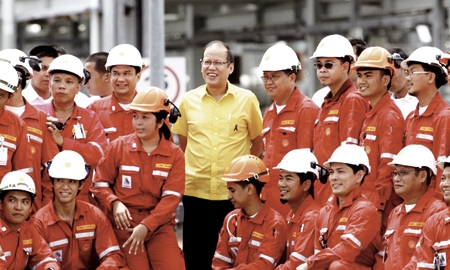Fifty miles northwest of Palawan Island lies one of the most important power sources in the Philippines. The Malampaya gas field contains some 2.7 trillion cubic feet of natural gas reserves and 85 million barrels of condensate.
Now in its eleventh year of operation, the Malampaya Deepwater gas-to-power project represents the first attempt to draw natural gas from beneath the waters of the Philippines. The largest and most significant industrial endeavour in the country, the project supplies natural gas to three power stations generating a combined 2,700 megawatts of electricity – enough to meet 42 per cent of the power requirements of Luzon, the largest Philippine island.
Accessing the gas, which is located some 10,000 feet below sea level, has raised major logistical, social, environmental and financial challenges. Overcoming them has been a triumph of joint effort by the national government and both Filipino and multinational companies.
State-of-the-art deepwater technology is used to extract the gas, which is then transported through flowlines to an offshore shallow water production platform for initial processing. Condensate is stored at the base of the platform while the dried gas is transported 300 miles via an underwater pipeline to an onshore gas processing plant in Batangas, on the southwestern part of Luzon. Two onshore pipelines transport the fuel to three gas-fired power stations.
The project is spearheaded by the Department of Energy and developed and operated by
Shell Philippines Exploration (
SPEX) with joint venture partners Chevron Malampaya LLC and the Philippine National Oil Company Exploration Corporation (PNOC). Shell and Chevron own 45 per cent, with the government holding the remaining 10 per cent through PNOC.
With an estimated capital outlay of about $4.5 billion (£2.87 billion), Phase 1 is considered the single biggest investment in the country. The second phase of development began in August last year, aimed at maintaining the level of gas production for the remaining life of the field.
A further $950 million is to be invested in drilling two additional wells and installation of compression capacity in Phases 2 and 3 of the project, to be completed in 2013 and 2015 respectively.
Energy Secretary Jose Rene Almendras says: “Phase 2 and Phase 3 will require us to re-invest so that we can prolong the supply of gas, because we need to get as much of the gas as we can.”
Last year marked the tenth anniversary of the commencement of natural gas production, which started at the site in 2001. Natural gas and oil were found at the site by Shell Philippines Exploration and partner Occidental Petroleum in May 1992. Fidel Ramos, the president at the time, signed the declaration of commerciality of the venture in 1998, and the project was inaugurated in October 2011 with a special ceremony at the onshore gas plant in Batangas.
The benefits the project brings are considerable for the Philippines, which historically has been forced to rely on imported fuel for the bulk of its domestic and industrial power requirements.
Rather than buying imported coal or low-sulphur oil as a source of power, the country is able to use indigenous gas that generates cost-competitive electricity. Reliance on imported fuel has been reduced by approximately 30 per cent, improving the trade balance and providing foreign-exchange savings.
The Malampaya project provides the Philippines with substantial revenues in the form of royalties to invest in additional infrastructure and other projects designed to stimulate economic growth. Under the service contract agreement, up to 70 per cent of the gross proceeds from the sale of the gas goes to the contractor to recover the investment cost. The government and the consortium share the remaining 30 per cent on a 60-40 basis respectively.
In January, President Aquino symbolically received a cheque for $1.1 billion, representing the government’s annual share from the project for 2011.
There are, of course, also environmental advantages in using natural gas, which is cleaner and more efficient than oil and coal, having the least CO2 among fossil fuels. Natural gas from Malampaya fuels the government’s pilot compressed natural gas for public transport, launched in 2008.

0 COMMENTS